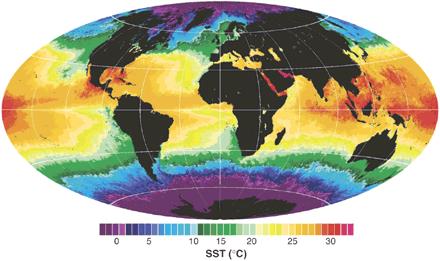
Climate Teleconnections
HydroLearn

Problem Statement
This module focuses on climate variability and the influence of remote oceanic and atmospheric conditions on regional precipitation and temperature. These are important concepts for understanding how the local water balance evolves over long periods of time, and also how extreme hydrologic events, e.g., floods and droughts, may result from climate patterns that are organized at global scales. Ocean and atmosphere interactions generate distinct patterns of space-time variability at time scales ranging from 30-60 days (Madden Julian Oscillation) to years (El Nino Southern Oscillation) to decades (Pacific Decadal Oscillation or the Atlantic Multidecadal Oscillation). These patterns lead to teleconnections or distinct responses in many parts of the world that can translate into periods of persistent flood or drought, or warm or cold spells.
Module Overview
Through this module, students will investigate the relationship between climate indices and regional hydrological conditions. Students will analyze the strength of teleconnections that are relevant to several regions of the United States of America (US), with an application in south Florida, and consider how climate teleconnections can be leveraged in improving seasonal and decadal water management in these locations. The module reviews the basics of both dynamical and statistical climate modeling, and guides the students through the process of building their own statistical model for the prediction of seasonal precipitation by leveraging the teleconnection relationships.
Topics Covered
The module is arranged in three sections, with each section containing background material and student learning activities. The sections include:
1. Climate variability, teleconnections, and their regional impacts. We discuss four teleconnections:
a) El Niño Southern Oscillation (ENSO)
b) Pacific Decadal Oscillation (PDO)
c) Atlantic Multidecadal Oscillation (AMO)
d) Madden-Julian Oscillation (MJO)
2. Climate Modeling and Forecasting
3. Statistical Tools for Precipitation Predictive Models
Pre-requisites
N/A
Learning Objectives
The objective of this module is to provide students with a basic understanding of climate teleconnections that have the potential to provide increased skill for precipitation forecasts and projections (over timescales ranging from seasonal to multidecadal). After completion of this module, students should be ready to consider how such teleconnections can inform and support hydrological modeling and design and water management analysis.
Course Authors


Emad Habib
University of Louisiana at Lafayette, , Lafayette, LA, USA. Contact: habib@louisiana.edu
Hanz Unruh
University of Louisiana at Lafayette, Lafayette, LA, USA. Contact: C00062543@louisiana.edu
Hisham Eldardiry
University of Washington, Seattle, WA. Contact: hishameldardiry@gmail.comTarget Audience
Junior/Senior undergraduate courses in Hydrology, Water Resources Engineering; introductory graduate courses in Hydro-Climatology. Students in water related fields that have not had a formal introduction to climate science are the target audience.
This module is motivated by the belief that bringing climate teleconnection information to the awareness of water engineers and policy makers can increase the efficacy of hydraulic designs and water management decision-making processes. However, this module does not directly focus on issues of hydraulic design, water management optimization, or decision-making. Instead, this module aims to provide the user with a basic understanding of climate teleconnections that have the potential to provide increased skill for seasonal to decadal precipitation forecasts and projections. In other words, this module will motivate students to consider the origin of the precipitation that you use as inputs for hydrological models and water management analysis.
Tools Needed
The student will need access to a computer and the Internet. The module exercises involve concept synthesis, data analysis, statistical analysis and plotting. Students will need to use a program they are most comfortable with (e.g. Excel, MATLAB, R, Python …). Some examples are provided in Excel and R
Suggested Implementation Mode
Based on the Authors’ experience, this module can be assigned as a standalone project and without breaking it into incrementally assigned sections. The design of the module is such that students should be able to complete all activities on their own with no intervention or help from the Instructor. As such, the Instructor may also choose to implement the module with a fully hands-off approach and ask the students to submit their solutions at the end of the three sections.
Course Sharing and Adaptation
This course is available for export by clicking the "Export Link" at the top right of this page. If you are an Instructor seeking the answer keys, please contact the course creators using your official University email account.
Make sure you cite the source of your new course (e.g., this course was adapted from Climate Teleconnections). You can include this citation on an "Adaptation Page" of your new course, in your course card, or in the introduction section of your new course.
Recommended Citation
Habib, E., Farnham, D., Eldardiry, H., Unruh, H. (2018) Analysis of Water Stress Across the United States. HydroLearn. https://edx.hydrolearn.org/courses/course-v1:HydroLearn+HydroLearn405+2019_S2/about.
Expected Total Hours
A student could expect to complete this module with approximately 30 work hours.
